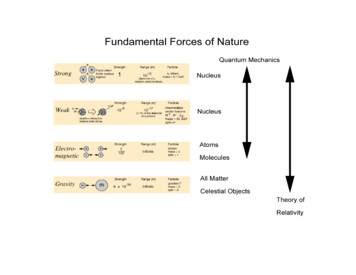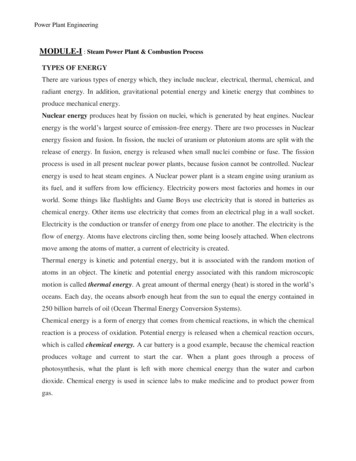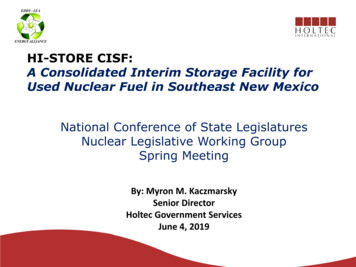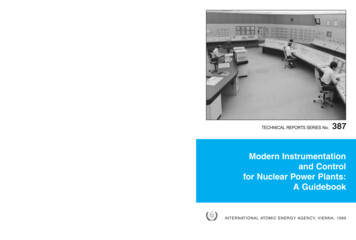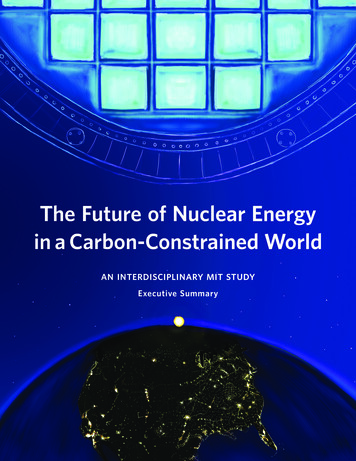
Transcription
The Future of Nuclear Energyin a Carbon-Constrained WorldAN INTERDISCIPLINARY MIT STUDYExecutive Summary
The Future of Nuclear Energyin a Carbon-Constrained WorldAN INTERDISCIPLINARY MIT STUDYExecutive Summary
Other Reports in the MIT Future of Series:The Future of Nuclear Power (2003)The Future of Geothermal Energy (2006)The Future of Coal (2007)Update of the Future of Nuclear Power (2009)The Future of Natural Gas (2011)The Future of the Nuclear Fuel Cycle (2011)The Future of the Electric Grid (2011)The Future of Solar Energy (2015)Copyright 2018 Massachusetts Institute of Technology.All rights reserved.Cover art by Sara Ferry, Nuclear Science and Engineering, MIT.2THE FUTURE OF NUCLEAR ENERGY IN A CARBON-CONSTRAINED WORLD
Study ParticipantsSTUDY CO-CHAIRSJacopo Buongiorno, Co-ChairAssociate Department Head and TEPCO Professor,Department of Nuclear Science andEngineering, MITMichael Corradini, Co-ChairProfessor Emeritus, Engineering Physics, Universityof Wisconsin-MadisonJohn Parsons, Co-ChairSenior Lecturer, Sloan School of Management, MITDavid Petti, Executive DirectorLaboratory Fellow, Nuclear Science and TechnologyDirectorate, Idaho National Laboratory; VisitingResearch Scientist, MITSTUDY GROUPRasheed AugusteUndergraduate Student, Department of NuclearScience and Engineering, MITPatrick ChamplinMaster’s Student, Department of Nuclear Scienceand Engineering, MITKaren DawsonPhD Candidate, Department of Nuclear Scienceand Engineering, MITZe (Jenny) DongUndergraduate Research Opportunities ProgramStudent, Department of Nuclear Science andEngineering, MITCharles ForsbergPrincipal Scientist, Department of Nuclear Scienceand Engineering, MITAndrew FossEnergy Options NetworkEric IngersollEnergy Options NetworkJoseph LassiterSenator John Heinz Professor of Management Practicein Environmental Management, Harvard BusinessSchool, RetiredJessica LoveringBreakthrough InstituteLucas RushMaster’s Student, Department of Nuclear Scienceand Engineering, MITNestor SepulvedaPhD Candidate, Department of Nuclear Scienceand Engineering, MITAmy UmaretiyaMaster’s Student, Technology and Policy Program, MITRobert VarrinDominion EngineeringPatrick WhiteMaster’s Student, Department of Nuclear Scienceand Engineering, MITDennis WhyteDepartment Head and Hitachi America Professor,Department of Nuclear Scienceand Engineering, MITKa-Yen YauUndergraduate Student, Department of NuclearScience and Engineering, MITRichard LesterAssociate Provost and Japan Steel Industry Professor,Office of the Provost, MITExecutive Summary3
Advisory CommitteePhilip Sharp (Chair)Former President, Resources for the FutureFormer U.S. CongressmanJean-Pierre BenquePresident Emeritus, EDF Development Inc.and EDF North AmericaRobert BudnitzProject Scientist, Retired, Lawrence BerkeleyNational LaboratoryJames Del FaveroCo-Founder, Ardea Partners LLCJohn DeutchInstitute Professor, MITDirector Emeritus, CIAMarvin FertelRetired President and Chief Executive Officer,Nuclear Energy InstituteSusan LandahlSenior Vice President, Exelon CorporationWilliam MagwoodDirector, Nuclear Energy AgencyFormer Commissioner, U.S. Nuclear RegulatoryCommissionDirector Emeritus, U.S. Department of Energy,Nuclear Energy OfficeKathryn McCarthyVice President for Research and Development,Canadian National LaboratoriesRichard MeservePresident Emeritus, Carnegie Institution for ScienceFormer Chairman, U.S. Nuclear RegulatoryCommissionAkira OmotoProfessor, Tokyo Institute of TechnologyAdvisor, Nuclear Risk Research CenterFormer Director, Division of Nuclear Power,International Atomic Energy Agency4THE FUTURE OF NUCLEAR ENERGY IN A CARBON-CONSTRAINED WORLDZack PateChief Executive Officer and Chairman Emeritus,Institute for Nuclear Power Operations andWorld Association of Nuclear OperatorsFormer U.S. Navy submarine commanderBernard SalhaSenior Executive Vice President and Presidentof Research and Development, EDFMichael ShellenbergerFounder and President, Environmental ProgressDirk SmitVice President Research Strategy, Chief ScientistGeophysics, Shell
ReviewersPhillip HildebrandtConsultantMark PetersLaboratory Director, Idaho National LaboratorySue IonChairman, UK Nuclear Innovation ResearchAdvisory BoardAndrew SherryChief Science and Technology Officer, UK NationalNuclear LaboratoryScott KempAssociate Professor, Department of Nuclear Scienceand Engineering, MITNeil TodreasProfessor Emeritus, Department of Nuclear Scienceand Engineering, MITAndrew KleinProfessor Emeritus, Nuclear Science and Engineering,Oregon State UniversitySUBJECT MATTER EXPERT REVIEWERSGeorge ApostolakisProfessor Emeritus, Department of Nuclear Scienceand Engineering, MITFormer Commissioner, U.S. Nuclear RegulatoryCommissionRobert ArmstrongDirector, MIT Energy Initiative; Chevron Professor ofChemical Engineering, Department of ChemicalEngineering, MITRebecca HendersonJohn and Natty McArthur University Professor,Harvard Business SchoolRobert HillNational Technical Director, Advanced Reactors,Argonne National LaboratoryChristopher KnittelGeorge P. Shultz Professor of Applied Economics, SloanSchool of Management; Director, Center for Energyand Environmental Policy Research, MITPaul JoskowElizabeth & James Killian Professor of Economicsand Management, Emeritus, Department ofEconomics, MITFrançois LévêqueProfessor of Economics, MINES ParisTechSteven ZinkleGovernor’s Chair Professor, Department of NuclearEngineering and Department of Materials Scienceand Engineering, University of Tennessee / OakRidge National LaboratoryDale KleinAssociate Vice Chancellor for Research for the UTSystem and Reese Endowed Professorship inEngineering, University of TexasFormer Chairman, U.S. Nuclear RegulatoryCommissionExecutive Summary5
6THE FUTURE OF NUCLEAR ENERGY IN A CARBON-CONSTRAINED WORLD
Table of ContentsForeword and AcknowledgmentsixExecutive SummaryxiBackground and OverviewxvChapter One: Opportunities for Nuclear Energy1Chapter Two: Nuclear Power Plant Costs31Chapter Three: Advanced Reactor Technology Evaluation59Chapter Four: Nuclear Industry Business Models and Policies95Chapter Five: Nuclear Reactor Safety Regulation and Licensing117Appendices149Abbreviations and Technical Terms247Executive Summaryvii7
viiiTHEFUTURENUCLEARENERGYCARBON-CONSTRAINEDWORLD8 WORLD
Foreword and AcknowledgmentsThe MIT Future of Nuclear Energy in a CarbonConstrained World study is the eighth in the MITEnergy Initiative’s “Future of” series, which aimsto shed light on a range of complex and importantissues involving energy and the environment.A central theme is understanding the role oftechnologies that might contribute at scale inmeeting rapidly growing global energy demandin a carbon-constrained world. Nuclear powercould certainly play an important role, and it wasthe subject of the first of these interdisciplinarystudies at MIT—the 2003 Future of Nuclear Powerreport. More recent studies have looked at theroles of CO2 sequestration, natural gas, the electricgrid, and solar power. Following a 2009 update tothe original nuclear study, now is an appropriatetime to take a fresh look at nuclear, given advancesin inherently safer technologies, a sharpenedfocus on the need to reduce CO2 emissions in theenergy sector, and challenges of cost and publicperceptions of safety.The study is designed to serve as a balanced, factbased, and analysis-driven guide for stakeholdersinvolved in nuclear energy. Policy makers, utilities,existing and startup energy companies, regulators,investors, and other power-sector stakeholderscan use this study to better understand thechallenges and opportunities currently facingnuclear energy in the U.S. and around the world.The report distills results and findings from morethan two years of primary research, a review ofthe state of the art, and quantitative modelingand analysis.The MIT Future of Nuclear Energy in a CarbonConstrained World study was supported by anumber of sponsors and was complementedby a distinguished Advisory Committee andReview Team. We gratefully acknowledge thesupport of our major sponsor The Alfred P. SloanFoundation and important contributions fromShell, Électricité de France (EDF), The David andLucile Packard Foundation, General Atomics, theAnthropocene Institute, MIT’s International PolicyLaboratory, Mr. Zach Pate, Mr. Neil Rasmussen,and Dr. James Del Favero. We also thank theIdaho National Laboratory, Dominion EngineeringInc., Blumont Engineering Solutions (Paul Meierand his JuiceBox work for Chapter 1), ProfessorGiorgio Locatelli from the University of Leeds(for his work on Megaprojects in Chapter 2), theBreakthrough Institute, and Lucid Strategy fortheir generous in-kind contributions. We also wishto acknowledge Professor Jessika Trancik andDr. James McNerny from the Institute for Data,Systems, and Society at MIT for their valuableinput to the analysis of the cost breakdown ofnuclear power plants.Our Advisory Committee members dedicateda significant amount of their time to participatein meetings and to comment on our preliminaryanalysis, findings, and recommendations.We would especially like to acknowledge theefficient conduct of Advisory Committee meetingsunder the able and experienced direction ofChairman Philip R. Sharp. Our review teamunder the leadership of Professor Andrew Kleinprovided valuable insight on our analysis, findings,and recommendations.Foreword andExecutiveAcknowledgmentsSummaryix9
The Study Team also wants to thank the following list of individuals who provided valuable input frominterviews and workshops conducted during the study:Kev AdjemianLaurent AmiceHenry AszklarScott BaileyWilliam BanholzerRita BaranwalJeff BartelmeElizabeth McAndrewBenavidesGary BergstromMichael BielmanRichard BradfordJonathan BrownHarlan BowersBob BoydVlad BulovićMarcia BurkeyNicolle ButcherJean-Marc CapdevilaCharles ChaseDoug ChapinIsmail ChengArmond CohenChristopher ColbertJustin ColemanMarco ComettoJim CostedioDavid DarwinFranck DavidMichael DavidsonPaul DeLucaJacques de ToniDave DillingSean DonnellyBradley DunkinPaul ErbAshley FinanMichael FordBen FrazierVince GilbertMike GoffCharles GordonDustin GreenwoodDaniele GiuffridaAbhinav GuptaPuja GuptaKathryn HeldRonald HenryBronwyn HylandDan IngersollSimon IrishRamzi JammalRick JefferysZabrina JohalLars JorgensenJake JurewiczJohn KellyJan-Horst KepplerEfe KurtAlbert LafleurBob LangerPhilippe LarochelleChristophe LevyNing LiFrank LingRobert LittlesGiorgio LocatelliEric LoewenWilliam LuytiesAudray LykeEd LymanIain MacdonaldMichel MaschiRegis MatzieJan MazurekWe wish to thank Carolyn Carrington for heradministrative support for all of the events,meetings, and workshops as part of this study;Marika Tatsutani for editing this report with greatskill and patience; Professor Robert C. Armstrongfor supporting this study in his role as Directorof the MIT Energy Initiative and as a reviewer;and MITEI Executive Director Martha Broad forproviding additional support and review.MITEI staff provided administrative and financialmanagement assistance to this project. We wouldparticularly like to thank project manager JenniferSchlick; Francesca McCaffrey and Ivy Pepin forMatthew McKinziePaul MeierTom MillerPhil MillsAlexander MishkinMike MyersSteve NanceMark NelsonRobert NielsenMarcus NicholMike O’ConnellFrank O’SullivanRory O’SullivanCharlie PainterBojan PetrovicJonathan PellishMark PeresPedro PereyraAndrew PinnekeBruce PhillipsNeil RasmussenRay RothrockTony RoulstoneJayant SabnisTim Saegerediting support; Debi Kedian, Carolyn Sinnes, andKayla Small for events support; and Emily Dahl,MITEI Director of Communications. We wouldalso like to thank Allison Associates for layoutand figure design.This report represents the opinions and views ofthe researchers, who are solely responsible forits content, including any errors. The AdvisoryCommittee and the Reviewers are not responsiblefor the findings and recommendations it contains,and their individual opinions and views may differfrom those expressed herein.Dedicated to the memory of our friend and colleague Mujid WORLDWORLDArthur SambergFrank SaundersChris SchuhJacob SelzerDaniel ShamblinFarshid ShahrokhiSanthosh ShankarDavid ShropshireJames StouchGarrett SonnenbergFinis SouthworthAndrew SowderMarc TannenbaumMathia TrojerJack TuohyFranz-Josef UlmEric Van AbelJan Van Der LeeChris VandervortJason WangKevan WeaverBrian WhitleyDon WolfOscar ZamoranoYaoli Zhang
Executive SummaryHarnessing the power of the atomic nucleusfor peaceful purposes was one of the mostastonishing scientific and technologicalachievements of the 20th century. It has benefittedmedicine, security, and energy. Yet, after a fewdecades of rapid growth, investment in nuclearenergy has stalled in many developed countriesand nuclear energy now constitutes a meager 5%of global primary energy production.We have surveyed recent light water reactor(LWR) construction projects around the worldand examined recent advances in cross-cuttingtechnologies that can be applied to nuclear plantconstruction for a wide range of advanced nuclearplant concepts and designs under development. Toaddress cost concerns, we recommend:(1)In the 21st century the world faces the newchallenge of drastically reducing emissionsof greenhouse gases while simultaneouslyexpanding energy access and economicopportunity to billions of people. We examinedthis challenge in the electricity sector, which hasbeen widely identified as an early candidate fordeep decarbonization. In most regions, servingprojected load in 2050 while simultaneouslyreducing emissions will require a mix of electricalgeneration assets that is different from thecurrent system. While a variety of low- or zerocarbon technologies can be employed in variouscombinations, our analysis shows the potentialcontribution nuclear can make as a dispatchablelow-carbon technology. Without that contribution,the cost of achieving deep decarbonization targetsincreases significantly (see Figure E.1, left column).The least-cost portfolios include an importantshare for nuclear, the magnitude of whichsignificantly grows as the cost of nuclear drops(Figure E.1, right column).Despite this promise, the prospects for theexpansion of nuclear energy remain decidedlydim in many parts of the world. The fundamentalproblem is cost. Other generation technologieshave become cheaper in recent decades, whilenew nuclear plants have only become costlier.This disturbing trend undermines nuclear energy’spotential contribution and increases the cost ofachieving deep decarbonization. In this study,we examine what is needed to arrest and reversethat trend.An increased focus on using proven project/construction management practices to increasethe probability of success in the execution anddelivery of new nuclear power plants.The recent experience of nuclear constructionprojects in the United States and Europe hasdemonstrated repeated failures of constructionmanagement practices in terms of theirability to deliver products on time and withinbudget. Several corrective actions are urgentlyneeded: (a) completing greater portions of thedetailed design prior to construction; (b) usinga proven supply chain and skilled workforce;(c) incorporating manufacturers and buildersinto design teams in the early stages of thedesign process to assure that plant systems,structures, and components are designed forefficient construction and manufacturing torelevant standards; (d) appointing a singleprimary contract manager with provenexpertise in managing multiple independentsubcontractors; (e) establishing a contractingstructure that ensures all contractors havea vested interest in the success of theproject; and (f) enabling a flexible regulatoryenvironment that can accommodate small,unanticipated changes in design andconstruction in a timely fashion.(2)A shift away from primarily field construction ofcumbersome, highly site-dependent plants to moreserial manufacturing of standardized plants.Opportunities exist to significantly reducethe capital cost and shorten the constructionschedule for new nuclear power plants. First,ExecutiveExecutive SummarySummaryxi11
the deployment of multiple, standardizedunits, especially at a single site, affordsconsiderable learning from the constructionof each unit. In the United States and Europe,where productivity at construction sites hasbeen low, we also recommend expanded useof factory production to take advantage of themanufacturing sector’s higher productivitywhen it comes to turning out complexsystems, structures, and components. Theuse of an array of cross-cutting technologies,including modular construction in factoriesand shipyards, advanced concrete solutions(e.g., steel-plate composites, high-strengthreinforcement steel, ultra-high performanceconcrete), seismic isolation technology, andadvanced plant layouts (e.g., embedment,offshore siting), could have positive impactson the cost and schedule of new nuclear powerplant construction. For less complex systems,structures, and components, or at sites whereconstruction productivity is high (as in Asia),conventional approaches may be the lowestcost option.It is important to emphasize the broad applicabilityof these recommendations across all reactorconcepts and designs. Cost-cutting opportunitiesare pertinent to evolutionary Generation-IIILWRs, small modular reactors (SMRs), andGeneration-IV reactors.1 Without designstandardization and innovations in constructionapproaches, we do not believe the inherenttechnological features of any of the advancedreactors will produce the level of cost reductionsneeded to make nuclear electricity competitivewith other generation options.designs. These concerns have led some countriesto renounce nuclear power entirely. To addresssafety concerns, we recommend:(3)A shift toward reactor designs that incorporateinherent and passive safety features.Core materials that have high chemical andphysical stability, high heat capacity, negativereactivity feedbacks, and high retention offission products, together with engineeredsafety systems that require limited or noemergency AC power and minimal externalintervention, will likely make operations simplerand more tolerable to human errors. Suchdesign evolution has already occurred in someGeneration-III LWRs and is exhibited in newplants built in China, Russia, and the UnitedStates. Passive safety designs can reduce theprobability that a severe accident occurs, whilealso mitigating the offsite consequences in theevent an accident does occur. Such designscan also ease the licensing of new plants andaccelerate their deployment in developed anddeveloping countries. We judge that advancedreactors like LWR-based SMRs (e.g., NuScale)and mature Generation-IV reactor concepts(e.g., high-temperature gas reactors andsodium-cooled fast reactors) also possess suchfeatures and are now ready for commercialdeployment. Further, our assessment of theU.S. and international regulatory environmentssuggests that the current regulatory systemis flexible enough to accommodate licensingof these advanced reactor designs. Certainmodifications to the current regulatoryframework could improve the efficiency andefficacy of licensing reviews.In addition to its high cost, the growth of nuclearenergy has been hindered by public concernsabout the consequences of severe accidents(such as occurred at Fukushima, Japan in 2011)in traditional Generation-II nuclear power plant1xii12 eactor designs are frequently classified into four generations. The first commercial nuclear reactors built in theRlate 1950s and 1960s are classified as Generation-I systems. Generation-II systems include commercial reactorsthat were built from 1970 to 1990. Generation-III reactors are commercial designs that incorporate evolutionaryimprovements over Generation-II systems. Generation-IV is the classification used to describe a set of advancedreactor designs that use non-water coolants and are under development today.THE FUTUREFUTURE OFOF NUCLEARNUCLEAR ENERGYENERGY ININ AA CARBON-CONSTRAINEDCARBON-CONSTRAINED WORLDWORLDTHE
Figure E.1: (left) Average system cost of electricity (in /MWhe) and (right) nuclear installed capacity (% of peak demand)in the New England region of the United States and the Tianjin-Beijing-Tangshan (T-B-T) region of China for different carbonconstraints (gCO2/kWhe) and three scenarios of various available technologies in 2050: (a) no nuclear allowed, (b) nuclearis allowed at nominal overnight capital cost ( 5,500 per kWe for New England and 2,800 per kWe for T-B-T), and (c) nuclearis allowed with improved overnight capital cost ( 4,100 per kWe for New England and 2,100 per kWe for T-B-T)Nuclear - NoneNuclear - Nominal CostNew England, United StatesNuclear - Low CostNuclear - Nominal250Nuclear Installed Capacity(% Peak Demand)Average Generation Cost ( /MWhe )New England, United States2001501005005001005010Emissions (g-CO2/kWh e )16050403020100500Nuclear - Nominal CostNuclear - Nominal2502001501005005001001005010Emissions (g-CO2/kWh e )1T-B-T ChinaNuclear - Low CostNuclear Installed Capacity(% Peak Demand)Average Generation Cost ( /MWhe )T-B-T ChinaNuclear - NoneNuclear -Low Cost7050Emissions (g-CO2/kWhe )101Nuclear -Low Cost1008060402005001005010Emissions (g-CO2/kWh e )1Simulations were performed with an MIT system optimization tool called GenX. For a given power market the required inputs includehourly electricity demand, hourly weather patterns, economic costs (capital, operations, and fuel) for all power plants (nuclear, wind andsolar with battery storage, fossil with and without carbon capture and storage), and their ramp-up rates. The GenX simulations wereused to identify the electrical system generation mix that minimizes average system electricity costs in each of these markets. The costescalation seen in the no-nuclear scenarios with aggressive carbon constraints is mostly due to the additional build-out and cost of energystorage, which becomes necessary in scenarios that rely exclusively on variable renewable energy technologies. The current world-averagecarbon intensity of the power sector is about 500 grams of CO2 equivalent per kilowatt hour (g/kWhe); according to climate changestabilization scenarios developed by the International Energy Agency in 2017, the power-sector carbon intensity targets to limit globalaverage warming to 2 C range from 10 to 25 g/kWhe by 2050 and less than 2 g/kWhe by 2060.ExecutiveExecutiveSummarySummaryxiii13
Lastly, key actions by policy makers are alsoneeded to capture the benefits of nuclear energy:(4)government should provide appropriatesupervision and support—including safetyprotocols, infrastructure, environmentalapprovals, and fuel-cycle services—and shouldalso be directly involved with all testing.Decarbonization policies should create a levelplaying field that allows all low-carbon generationtechnologies to compete on their merits.(6)Investors in nuclear innovation must seethe possibility of earning a profit based onselling their products at full value, whichshould include factors such as the value ofreducing CO2 emissions that are externalto the market. Policies that foreclose a rolefor nuclear energy discourage investment innuclear technology. This may raise the costof decarbonization and slow progress towardclimate change mitigation goals. IncorporatingCO2 emissions costs into the price of electricitycan more equitably recognize the value to allclimate-friendly energy technologies. Nucleargenerators, both existing plants and the newbuilds, would be among the beneficiaries of alevel, competitive playing field.(5)Governments should establish reactor siteswhere companies can deploy prototypereactors for testing and operation oriented toregulatory licensing.Such sites should be open to diverse reactorconcepts chosen by the companies thatare interested in testing prototypes. WORLDTHEGovernments should establish funding programsaround prototype testing and commercialdeployment of advanced reactor designs usingfour levers: (a) funding to share regulatorylicensing costs, (b) funding to share researchand development costs, (c) funding for theachievement of specific technical milestones,and (d) funding for production credits to rewardsuccessful demonstration of new designs.Many more findings emerged in the course of theresearch undertaken for this study. A detaileddiscussion of these findings is contained in theoverview and main body of the study report,which is organized into five major topic areas(with corresponding chapter titles): Opportunitiesfor Nuclear Energy, Nuclear Power Plant Costs,Advanced Reactor Technology Evaluation, NuclearIndustry Business Models and Policies, andNuclear Reactor Safety Regulation and Licensing.
studies at MIT—the 2003 Future of Nuclear Power report. More recent studies have looked at the roles of CO 2 sequestration, natural gas, the electric grid, and solar power. Following a 2009 update to the original nuclear study, now is an appropriate time to take a fresh look at nuclear, giv
